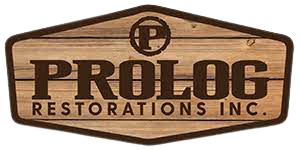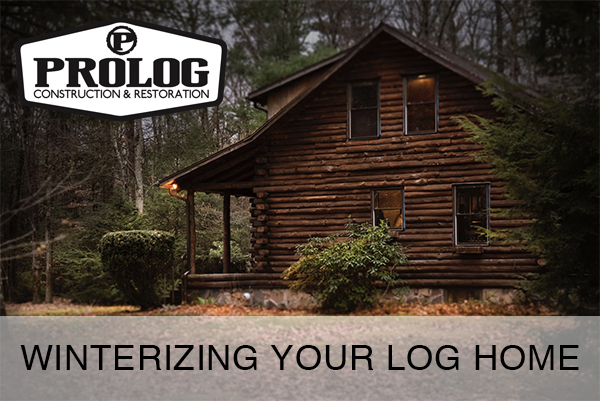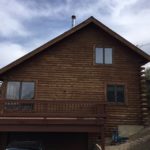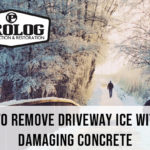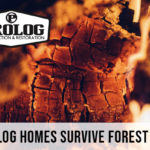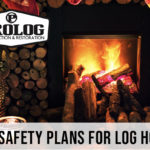Is your log home ready for winter? We’ve rounded up our best tips for winterizing, what you can do on your own, and when you should call a pro to get your log home ready for the harshest season of the year.
Log home maintenance for the winter season should be done before the first snow or freezing temperatures hit. Here in California that means you want to get started in September or early October at the latest. Many of these tasks can be completed by the homeowner, but if you need professional assistance you can always call ProLog Restorations for questions, quotes or advice at 877-477-6564.
Ready? Let’s get started using our ultimate guide for winterizing log homes:
Check for Water Leaks
Rainstorms and melting snow can drive water into log cabins that have not been maintained over the years. Homes located in unprotected areas such as on a mountain ridgeline can also be in danger as strong winds can push rain nearly horizontally into cracks and crevices.
If you notice water stains, wet areas or suspicious spots contact a professional log home maintenance company, like ProLog Restorations, for an inspection and repairs if needed. Also, be sure to read this article, How to Find Water Leaks in Your Log Home, to learn more about finding and fixing water leaks.
Fixing water leaks when you find them can be as simple as filling in gaps with caulking or repairing the existing chinking. If you suspect a water leak, but can’t find where it came in, a log home professional can use thermal imaging technology to track it down.
If you have water leaks in your log home, or suspect there might be, give us a call at (877) 477-6564. ProLog Restorations is professionally certified, licensed, bonded, and insured and our work is 100% satisfaction guaranteed. Our experienced log home professionals can help you find water leaks, repair water damage, and check for any other issues that need attention before winter rolls around again.
Winterizing Your Roof
Most log homes are located at higher elevations and more likely to get lots of snow or ice in the winter. Making sure your roof is ready for winter can save you lots of money and stress in the future.
First thing to do is check for loose or damaged shingles or raised nails on the roof. If you can safely make the repairs on your own, that’s fine. But it’s a good idea to call an expert log home contractor like ProLog Restorations for a consultation as there could be more damage hiding underneath.
Your next task is to clean gutters and downspouts and check for loose connections, leaks or damage. Leaks and damage to your gutters can cause mold or mildew buildup that will harm logs and cost you a lot down the road for log repair or replacement. With the right conditions, layers of snow that build up on clogged gutters can turn into an ice dam, with the potential to harm your home, property, and even people walking underneath.
Ice Dams
Ice dams are a common issue that can cause some serious damage for log homes and getaway cabins. These are thick ridges of solid ice that build up along the eaves. As ice and snow accumulate, melting water from the ice dam can back up under the roof shingles and leak into the attic. That water will soak through the insulation and trickle down into your home – staining ceilings and causing long-lasting moisture damage inside the walls and ceiling. Additionally, the sheer weight of ice dams can force gutters and downspouts to pull away from the house, often damaging logs, porches, windows and more as they come down.
There are a few things you can do to lower the potential of ice dams forming on your log home or cabin getaway. Some can be done on your own, others might need help from ProLog Restorations. Check out this article, How to Prevent and Remove Ice Dams on Log Homes, for tips on preventing ice dams and protecting your log home.
Chimney Maintenance
Before snow blocks your view, use binoculars to thoroughly check chimneys for cracked mortar or flue pipes, debris such as bird’s nests, and white or green stains that signal mold or mildew. Any gaps, cracks, and crumbling mortar in the chimney allows moisture to get inside.
An easy way to make sure your chimney is winter-ready is to have it inspected by a professional. If you use your chimney heavily, it might need a cleaning. Creosote, soot and ash can build up inside, blocking ventilation and causing smoke and dangerous fumes to come back into the home.
There are other steps that can be taken to protect your chimney such as waterproofing the outside and installing a cricket to channel water and debris away. For more details, and tips for wood-burning stoves see How to Winterize Log Cabin Chimneys.
Windows and Walls
Check weather stripping and caulking around edges of all windows for leaks or water stains. Take a look at caulking around windows, doors, exhaust pipes and near fireplace.
Walk around the home and check outer walls for cracks in the logs or chinking, knots that are popping out, signs of insect damage, water stains, soft and porous wood, mold or mildew. Make note also of any discoloration as well as flaking or peeling stain. Make a list of possible issues, take photos, and contact ProLog Restorations for their expert opinion on any action you might need to take.
Outdoor Hoses and Faucets
As you check the outside of your log home also check for and repair water spigots or outdoor faucets that are leaking. For outdoor faucets that cannot be drained during the winter, you can protect them by installing frost-free hose bib covers.
Hose bib covers are square or dome-shaped devices made to fit over and around outdoor faucets. They are made of thick foam which makes them very effective at keeping much of the cold away from the valve. For more details, photos and how-to’s read How to Winterize Outdoor Faucets and Fixtures.
Drafty Cabins
Another common issue that can make life very uncomfortable in the winter is a drafty cabin. As logs expand and contract with the changing seasons, cracks can form that let in air and ruin your cozy factor. Dry climates can also cause drafts as moisture evaporates out of logs, creating tiny cracks that widen over time.
For sneaky drafts that are hard to find, we use thermal imaging here at ProLog Restorations to pinpoint exactly where air is getting in. Thermal imaging, also called thermography, is the process of using a special camera in a room that can measure differences in air temperature and share the results on a computer for log home maintenance experts to analyze. A typical thermal imaging survey includes details of where and how air is getting into the room, making it easier to correct the problem.
Use this guide to get your log home prepped and ready for winter weather and you can relax that your home will be snug and cozy all season long. For questions or quotes to winterize your log home, feel free to give the ProLog Restorations professionals a call at 877-477-6564.
